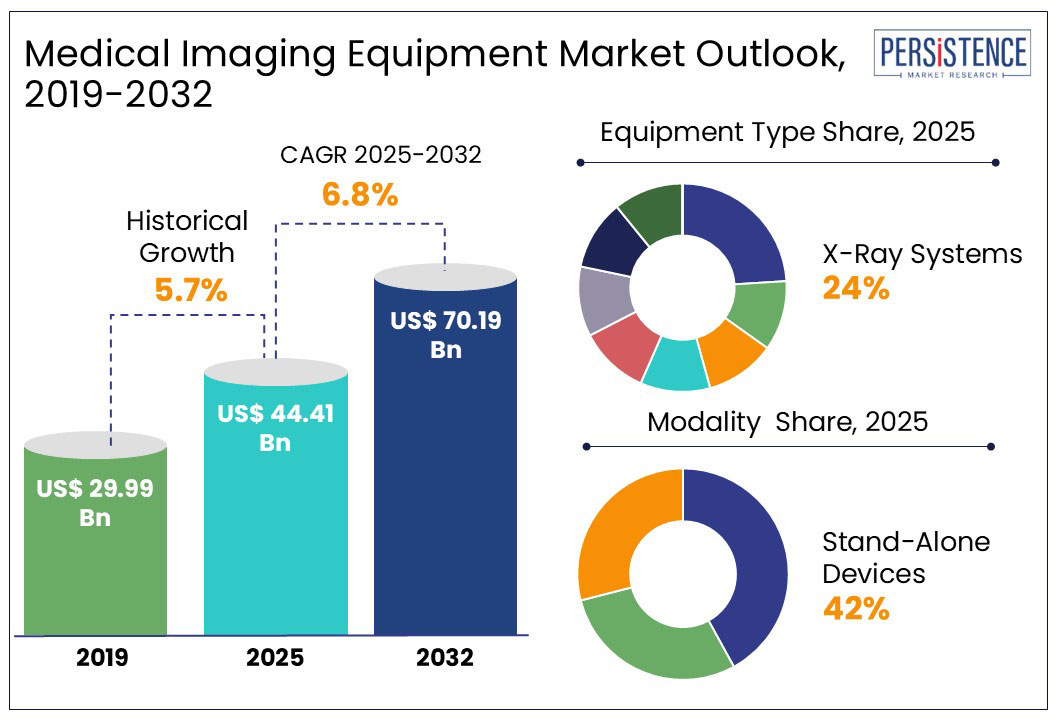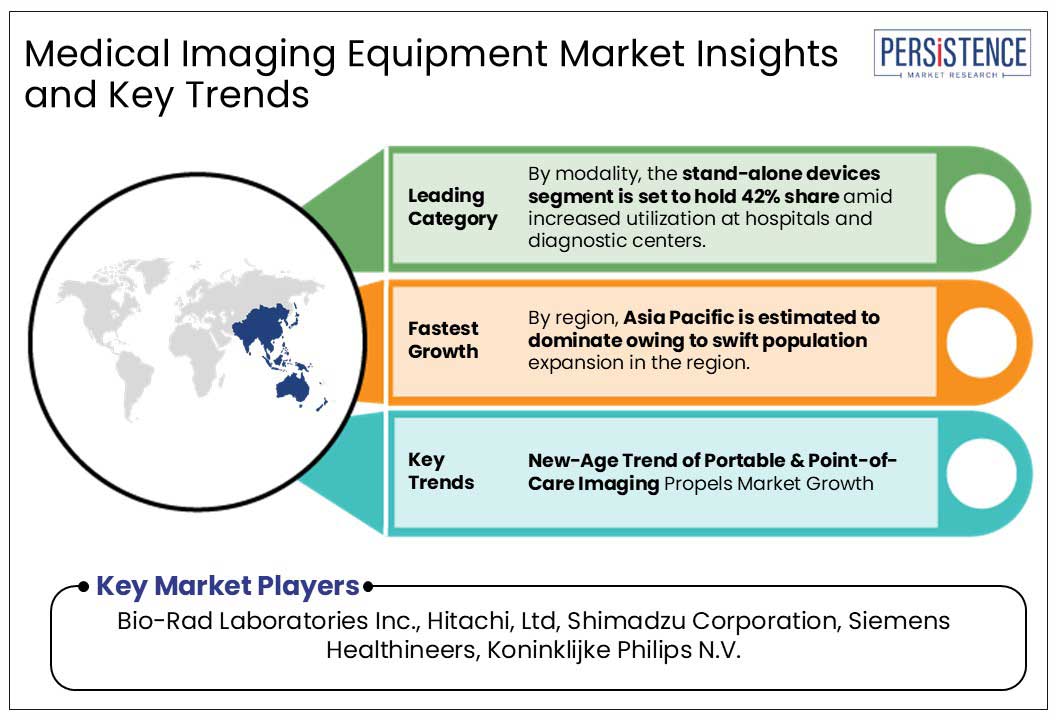Industry: Healthcare
Published Date: February-2025
Format: PPT*, PDF, EXCEL
Delivery Timelines: Contact Sales
Number of Pages: 198
Report ID: PMRREP11215
The global medical imaging equipment market size is anticipated to rise from US$ 44.41 Bn in 2025 to US$ 70.19 Bn by 2032. It is projected to witness a CAGR of 6.8% from 2025 to 2032.
In the ever-evolving healthcare technology landscape, few advancements have been as transformative as those in medical imaging. As patient needs grow and healthcare systems strive for greater efficiency, cutting-edge imaging equipment has become a cornerstone of modern diagnostics.
From X-ray machines and CT scanners to MRI systems and ultrasound devices, these technologies provide invaluable insights that shape patient outcomes and guide clinical decision-making.
Among these innovations, X-ray technology has remained at the forefront, continuously adapting to meet the demands of contemporary medicine. However, a ground-breaking shift is now redefining how radiologists interpret and diagnose medical conditions.

Key Highlights of the Medical Imaging Equipment Market
|
Global Market Attributes |
Key Insights |
|
Medical Imaging Equipment Market Size (2025E) |
US$ 44.41 Bn |
|
Market Value Forecast (2032F) |
US$ 70.19 Bn |
|
Projected Growth (CAGR 2025 to 2032) |
6.8% |
|
Historical Market Growth (CAGR 2019 to 2024) |
5.7% |
Shift from Analog to Digital Imaging Aided the Growth of the Market by 2024
During the historical period from 2019 to 2024, the medical imaging industry saw a transformative shift from analog to digital imaging, driving market growth. Hospitals and diagnostic centers rapidly adopted high-resolution MRI, CT, and ultrasound machines, improving diagnostic accuracy.
The COVID-19 pandemic further accelerated demand for portable X-ray and CT scanners, though supply chain disruptions and high equipment costs posed challenges, especially in emerging markets.
AI-Driven Imaging Further Shapes the Future of Healthcare
Looking ahead, AI-powered automation, portable imaging solutions, and expanding healthcare investments will fuel exponential market growth. AI is revolutionizing radiology workflows, reducing diagnosis time, and enhancing accuracy.
The rise of wireless ultrasound and mobile X-ray devices is making point-of-care diagnostics more accessible, particularly in rural areas.
Governments in Asia Pacific, Latin America, and Africa are expanding healthcare infrastructure, ensuring advanced imaging technologies reach underserved regions. With AI streamlining diagnostics, the future of medical imaging promises faster, more precise, and widely accessible healthcare solutions.
Growth Drivers
Increasing Prevalence of Chronic Diseases & Aging Population to Boost Market Growth
As chronic diseases such as cancer, cardiovascular conditions, and neurological disorders become more prevalent, the demand for advanced medical imaging is reaching new heights.
Routine scans have become essential for early detection, treatment monitoring, and disease management, making MRI and CT scans indispensable in modern healthcare.
One of the most significant factors driving this surge is the aging global population. With one in six people expected to be over 65 by 2050, the need for osteoporosis and arthritis screenings, cardiovascular assessments, and neurological evaluations is growing rapidly.
To meet this demand, the healthcare industry is investing in faster, more precise, and patient-friendly imaging solutions.
Innovations in high-resolution imaging, AI-assisted diagnostics, and portable scanning devices ensure that elderly and chronically ill patients receive quicker and more comfortable diagnostic experiences, shaping the future of medical imaging.
High Cost and Low Adoption of Medical Imaging Devices in Underserved Regions are Major Barriers to Market's Growth
While advanced medical imaging technologies have revolutionized healthcare, their high cost remains a significant barrier, particularly in underserved regions.
X-ray machines, MRI scanners, and CT scanners come with a hefty price tag, making them inaccessible to many hospitals and diagnostic centres in developing nations. As a result, more affordable alternatives like ultrasound imaging are often used, even when digital radiology would provide greater diagnostic accuracy.
Beyond financial constraints, patient-related factors also contribute to slow adoption rates. A notable example is claustrophobia, which affects many patients undergoing MRI scans. Despite the availability of high-resolution imaging equipment, discomfort and anxiety can prevent patients from choosing these advanced diagnostic tools, even when they come at a premium price.
As the global healthcare industry strives for greater accessibility and efficiency, efforts must be made to develop cost-effective imaging solutions and improve patient-friendly innovations.
Without addressing these challenges, the adoption of cutting-edge medical imaging technology may remain uneven, slowing the market’s full potential for expansion.
Rise of Portable & Point-of-Care Imaging is Revolutionizing Diagnostics
With the advent of portable and point-of-care imaging devices, healthcare is becoming more accessible, efficient, and patient-centric. From handheld ultrasound devices to mobile X-ray machines and compact MRI scanners, these innovations transform how and where medical imaging is performed.
Access to advanced diagnostic tools has traditionally been limited for patients in rural and underserved areas. Traveling long distances to hospitals for essential scans often leads to delayed diagnoses and overburdened healthcare facilities. However, portable imaging solutions are bridging this gap, enabling faster, on-the-spot assessments and reducing hospital congestion.
The demand for home-based diagnostics and point-of-care imaging is accelerating as the global healthcare industry shifts toward decentralized care. Emerging companies are capitalizing on this trend, developing battery-operated, wireless, and AI-enhanced imaging systems that provide precision diagnostics anywhere, anytime.
With AI integration improving image analysis and real-time diagnostics, these innovations are set to reshape the future of medical imaging, making quality healthcare accessible to all.
Equipment Type Insights
Increasing Application of X-Ray Systems to Acquire 24% of the Market Share by Equipment Type
The demand for advanced X-ray systems is growing rapidly, driven by changing consumer needs and technological advancements.
As bedside monitoring becomes more prevalent and urgent care facilities expand, healthcare providers require faster, more efficient, and highly precise imaging solutions to diagnose and treat patients in real-time.
The surge in demand is reshaping how X-ray technology is utilized across multiple sectors, particularly in emergency medical services and pharmaceutical research. Beyond traditional medical imaging, X-ray techniques are revolutionizing drug development.
X-ray powder diffraction (XRPD) has emerged as a powerful analytical tool in the pharmaceutical industry, offering unparalleled accuracy in studying drug formulations and material compositions.
Researchers now rely on this technology to analyze crystalline structures, ensure product stability, and enhance drug efficacy, which are critical factors in pharmaceutical innovation. The rapid advancement of fast X-ray detectors, along with cutting-edge hardware and software improvements, has dramatically reduced measurement times and enhanced detection limits.
What was once a time-intensive process now delivers real-time, high-precision data, accelerating drug research, development, and manufacturing breakthroughs.
As X-ray technology continues to evolve, its impact extends beyond diagnostics, it is shaping the future of healthcare, pharmaceuticals, and life sciences, providing essential insights that drive innovation and improve patient care worldwide.

Increased Utilization of Stand-Alone Imaging Devices at Hospitals and Diagnostic Centers Propels Market Demand
In the rapidly evolving world of medical diagnostics, stand-alone imaging devices have emerged as the backbone of healthcare facilities, holding a 42% share of the total market. While home-based diagnostics are on the rise, most patients still prefer in-person diagnosis and treatment, a trend that continues to drive the growth of stand-alone imaging systems.
Walk-in patients at hospitals, diagnostic imaging centres, and specialty clinics benefit from immediate access to advanced imaging technologies, ensuring accurate and timely diagnoses under healthcare professionals' guidance. These settings provide a higher level of medical oversight, allowing physicians to make informed treatment decisions based on high-resolution imaging results.
With a growing patient pool and increasing demand for precision-driven diagnostics, stand-alone imaging devices are being utilized more than ever. Their ability to deliver quick, detailed scans in a controlled medical environment makes them indispensable in streamlining patient care, reducing diagnostic delays, and improving treatment outcomes.
As healthcare facilities continue to expand and modernize, the reliance on stand-alone imaging systems is set to strengthen further, shaping the future of diagnostic excellence.
Growing Adoption of Medical Imaging Technology Caters North America to Lead the Market with 37% of the Market Share
The North America medical imaging market dominates with a 37% of the total revenue share. The region's dominance can be attributed to the increased adoption of medical imaging technology in primary care environments. The enhanced accessibility and substantial healthcare expenditure in North American nations with effective payment regimes is a crucial market-driving element.
Further, the rising prevalence of chronic diseases in the North American region, such as breast cancer, cardiovascular ailments, and neurological conditions, has generated a significant need for imaging analysis.
In 2024, the US medical imaging equipment market constituted a substantial portion of the North American market, propelled by advancements in technology, shifts in patient care techniques, and shifting epidemiological trends.
Europe Medical Imaging Equipment Market to Propel with Increased Investments in R&D Activities
The European medical imaging industry is experiencing rapid expansion driven by increased investments in research & development from both public and private sectors. The key reason for this growing investments are the need for high-end healthcare apparatus.
The increasing need for healthcare apparatus and the widespread occurrence of chronic and pain-related ailments in the region are primary factors anticipated to enhance market growth further.
Key European countries including the UK, Germany, France, Italy play a vital role in the region’s growth as an emerging healthcare hub, with the UK being a more promising sector in the region. The rise in General Practice (GP) referrals for MRI tests in the UK is anticipated to enhance the demand for MRI equipment.
Asia Pacific Medical Imaging Equipment Market to Witness Fastest Growth
Followed by North America and Europe, Asia Pacific is the third largest region in terms of revenue share and is the fastest growing region. Countries like India and Japan are heading towards becoming the most trusted and economical healthcare destinations worldwide, which is a key reason for the growth of the region.
Another crucial factor for the region's fastest growth can be attributed to the swift population expansion and growing research and development activities in healthcare sector. India is at the forefront when it comes to medical treatments and surgeries, as the nation is trusted for its healthcare infrastructure and efficient and economical medical assistance globally.
According to Persistence Market Research studies, the Indian medical imaging market is projected to rapidly expand over the forecast period, driven by rising birth rates, increased awareness of prenatal care, and economic reform initiatives.
Numerous manufacturers are investing and extending their operations in this region, enhancing regional market growth.
The medical imaging equipment market is highly competitive, with key players focusing on technological advancements, strategic collaborations, and market expansion.
Major companies in the industry, compete in MRI, CT, ultrasound, and X-ray modalities. Increasing AI integration and portable imaging solutions drive innovation. Startups and mid-sized firms enhance competition with cost-effective and specialized solutions.
Emerging markets in Asia Pacific and Latin America offer growth opportunities, intensifying global competition. Price wars, service differentiation, and R&D investments remain crucial competitive factors.
Key Industry Developments
|
Report Attributes |
Details |
|
Historical Data/Actuals |
2019 - 2024 |
|
Forecast Period |
2025 - 2032 |
|
Market Analysis Units |
Value: US$ Bn/Mn, Volume: As applicable |
|
Geographical Coverage |
|
|
Segmental Coverage |
|
|
Competitive Analysis |
|
|
Report Highlights |
|
|
Customization and Pricing |
Available upon request |
By Equipment Type
By Modality
By Application
By End User
By Region
To know more about delivery timeline for this report Contact Sales

The market is set to reach US$ 44.41 Bn in 2025.
Bio-Rad Laboratories Inc., Hitachi, Ltd, Shimadzu Corporation, are a few leading players.
The industry is estimated to rise at a CAGR of 6.8% through 2032.
North America is projected to hold the largest share of the industry in 2025.
The market is anticipated to reach a valuation of US$ 70.19 billion by 2032.